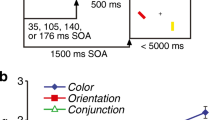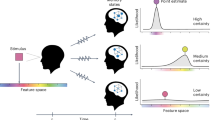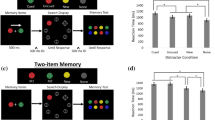Abstract
The number of objects that can be maintained in visual working memory without interference is limited. We present simulations of a model of visual working memory in ventral prefrontal cortex that has this constraint as well. One layer in ventral PFC constitutes a ’blackboard’ representation of all objects in memory. These representations are used to bind the features (shape, color, location) of the objects. If there are too many objects, their representations will interfere in the blackboard and therefore the quality of these representations will degrade. Consequently, it becomes harder to bind the features for any object maintained in memory, which reduces the capacity of working memory.
Access this chapter
Tax calculation will be finalised at checkout
Purchases are for personal use only
Preview
Unable to display preview. Download preview PDF.
Similar content being viewed by others
References
Vogel, E.K., Woodman, G.F., Luck, S.J.: Storage of features, conjunctions, and objects in visual working memory, Journal of Exp. Psychol.: HPP 27 (2001) 92–114
Van der Velde, F., de Kamps, M.: A model of visual working memory in PFC, Neurocomputing (2003) (in press)
Van der Velde, F., de Kamps, M.: From knowing what to knowing where: Modeling object-based attention with feedback disinhibition of activation, J. Cognitive Neurosci. 13(4) (2001) 479–491
Duncan, J.: An adaptive coding model of neural function in prefrontal cortex, Nature Rev. Neurosci. 2(11) (2001) 820–829
De Kamps, M., van der Velde, F.: Using a recurrent network to bind form, color and position into a unified percept. Neurocomputing 38-40 (2001) 523–528
De Kamps M., van der Velde, F.: From artificial neural networks to spiking neuron populations and back again. Neural Networks 14 (2001) 941–953
Author information
Authors and Affiliations
Editor information
Editors and Affiliations
Rights and permissions
Copyright information
© 2006 Springer-Verlag Berlin Heidelberg
About this paper
Cite this paper
van der Voort Kleij, G.T., de Kamps, M., van der Velde, F. (2006). A Neural Model of Binding and Capacity in Visual Working Memory. In: Kaynak, O., Alpaydin, E., Oja, E., Xu, L. (eds) Artificial Neural Networks and Neural Information Processing — ICANN/ICONIP 2003. ICANN ICONIP 2003 2003. Lecture Notes in Computer Science, vol 2714. Springer, Berlin, Heidelberg. https://doi.org/10.1007/3-540-44989-2_92
Download citation
DOI: https://doi.org/10.1007/3-540-44989-2_92
Published:
Publisher Name: Springer, Berlin, Heidelberg
Print ISBN: 978-3-540-40408-8
Online ISBN: 978-3-540-44989-8
eBook Packages: Springer Book Archive




